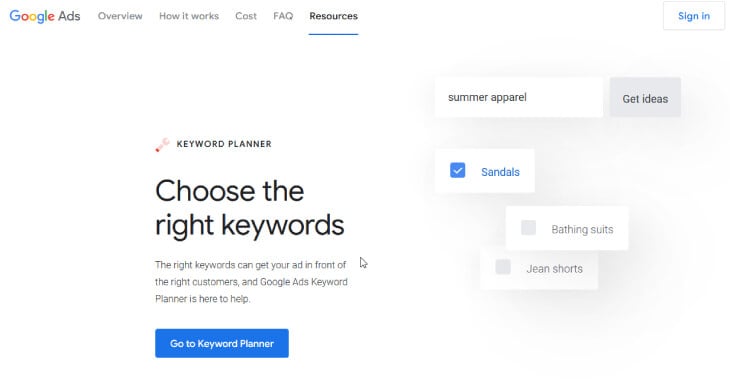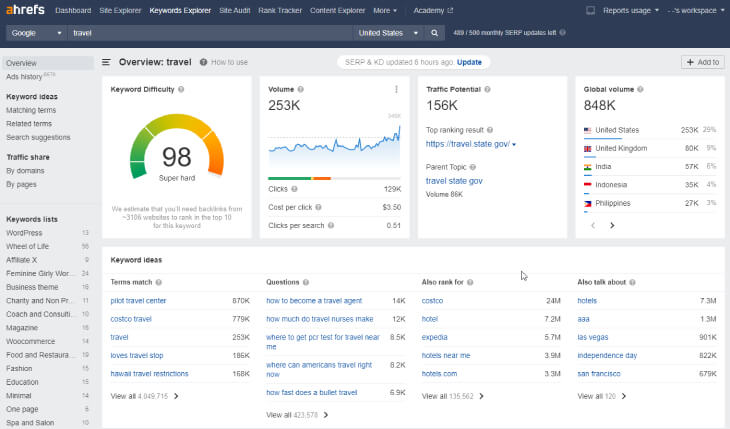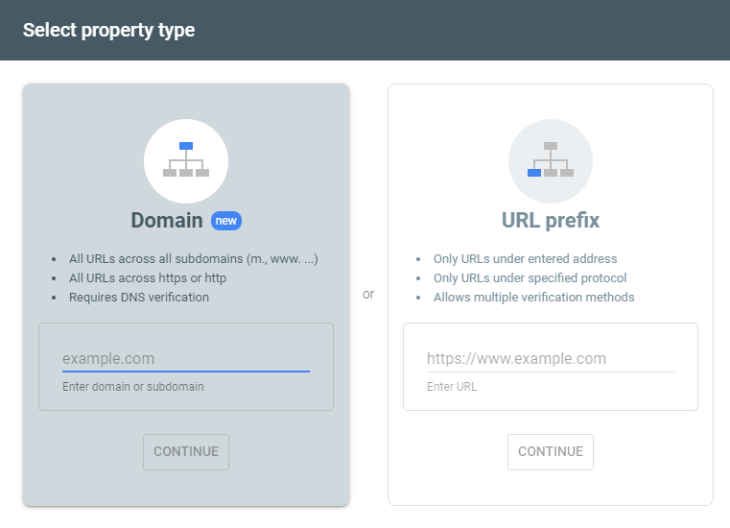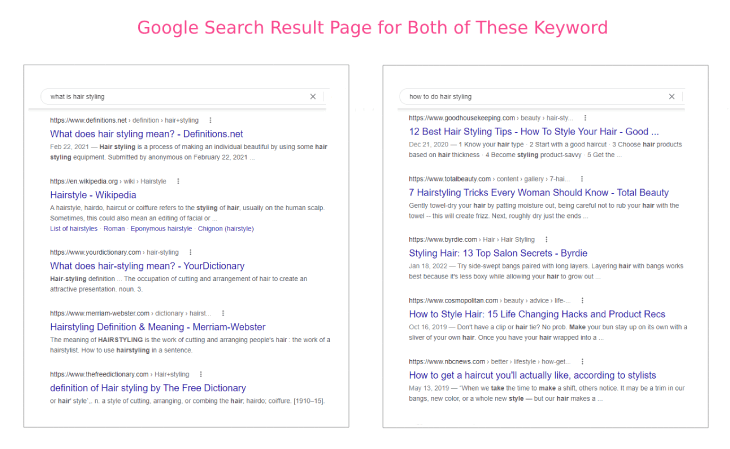Have you ever noticed Google’s homepage?
What you see is a text input field with a search button. That’s it!
Everything begins with a few words typed into the search engine, and Google’s search algorithm looks for the content or website containing that particular keyword.
If you cannot rank your website or blog post for the searched keywords, you will not be able to drive traffic from the organic search.
That is why keyword research is critical for every website or blog post to increase traffic through ranking.
Therefore, this article will show you the methods or techniques that will help you find the right keyword to rank your website higher in the search engine.
What is Keyword Research?
Keyword Research is the process of finding and selecting the best terms and phrases that people are most likely to use when searching for specific products, services or content. It involves targeting the right keywords that will help you rank higher in the search engine results pages (SERPs).
Types of Keywords:
Keywords can be classified into four categories on the basis of the user’s search intention: informational, navigational, transactional and commercial.
- Informational Keywords – Searchers who are looking for information on a particular topic use informational keywords. They may use the words like “How,” “What,” “Why,” “Tutorial,” and “Guide.”
For example, if you are searching for an article about “what is the best WordPress theme”, this would be an informational keyword.
- Navigational Keywords – These keywords are typically used by people who already know what they’re looking for and are just searching for a specific website or piece of content.
In case someone is looking for the Blossom Themes, they might use the keyword “Blossom Themes” and find the official site of Blossom Themes.
- Commercial Keywords – These keywords are used by searchers who are looking to buy something but don’t necessarily have a specific product in mind.
They may use words and phrases like “Best,” “Top,” “Reviews,” and “Comparisons.” These keywords intend to find the best product for the user’s needs.
For instance, someone might use the keyword “Best WordPress Themes” if they are looking for a list of themes to choose from.
- Transactional Keywords – Transactional keywords are used by searchers who are ready to buy something.
They may use words like “Buy,” “Purchase,” “Deals,” “Discounts,” and “Coupons.” The intent of these keywords is to locate products related to those terms.
For example, someone might use the keyword “Buy Washing Machine” if they are looking to purchase a washing machine.
Why is Keyword Research Important?
As said earlier, the main objective of keyword research is to find the right keywords that are relevant to your topic.
If you’re targeting the wrong keyword, all your SEO efforts will go in vain.
You might have the best content on your blog, but if you’re not targeting the right keyword, you will never rank higher in the Search Engine Results Pages (SERPs) no matter how hard you try.
On the other hand, if you’re able to find and target the right keyword, half your job is done.
Keyword research is essential to:
- Gain an understanding of what people are searching for online.
- Find keywords that your competitors are targeting.
- Know how hard it will be to rank for a particular keyword.
- Know what kind of content you should create to rank for a specific keyword.
So, if you’re serious about driving organic traffic to your website, you need to start your SEO campaign with keyword research.
How to Find Keywords the Right Way?
There is no such thing as a one-size-fits-all approach to performing keyword research. The best approach for keyword research varies depending on your niche and content goals.
Nonetheless, there are a few standard tips and strategies that have worked for websites across all niches:
Brainstorm your keyword
The first step in keyword research is to brainstorm a list of keywords that you think are relevant to you.
To do this, you can think about your blog content, products or services you offer and your target audience’s problems. For example, if you sell hair care products, your target audience may have problems such as dandruff, curly hair, or split ends. So, you can create content with keywords like “How to get rid of dandruff?”.
You can also think about the questions that people are likely to ask about your products or services. For example, some related topics about hair care products could be how to moisturize dry hair, how to style long straight hair, etc.
Besides that, you can also seek out the opinions of friends and family or people who work in the same industry. They can offer valuable insights and help you generate ideas that are best for you.
Most importantly, you can take the help of Google Autocomplete. It is a Google Search feature where the search box shows possible words that might complete a user’s query. Trust me, if Google is suggesting them, that means there are lots of people searching for those terms.

Use Keyword Research Tools
It is nearly impossible to manually look through all the search results to find the best keywords for your website.
That’s where keyword research tools come in. It helps you to explore all the data and analytics of a particular keyword with a single click.
There are various keyword research tools available on the internet. Here we will discuss a few of the best keyword research tools:

Semrush is a powerful tool that improves your online visibility and gives you better marketing insights. With tools for SEO, PPC, SMM, Keyword Research, Competitive Research, PR, Content Marketing, and Marketing Insights, Semrush has everything you need to take your online marketing to the next level.

Google Trends displays how often a certain search term is entered into Google’s search engine compared to the site’s overall search activity. Google Trends can be used to do keyword research and track event-driven spikes in keyword usage.

AnswerThePublic is a valuable tool to understand what consumers are searching for. By visualizing suggested searches from Bing and Google, AnswerThePublic provides an overview of the questions people are asking online. This information is precious for search marketers who want to streamline their content and optimize for long-tail keywords.

Google Keyword Planner is a free tool that helps you research keywords for your search campaigns. You can discover new keywords related to your products or services, see estimates of the monthly searches they receive, and determine the cost to target them. You can also organize keywords into different categories related to your brand.

Ahrefs is an all-in-one SEO software suite that helps marketing professionals with link building, keyword research, competitor analysis, rank tracking and site audits. With Ahrefs, you can grow your organic traffic and improve your search engine rankings.
To do keyword research using Ahrefs, you need to follow the following steps:
First, log into your ahrefs account. After logging in, you need to click on the Keywords Explorer tab at the top bar.

Next, add one of your seed keywords into the text input field and click on the search button. For example, if you run a travel business, let’s enter “Travel” as your seed keyword and see what it kicks back:

You’ll notice that Ahrefs provides you an overview of the Keyword you entered, like volume, keyword difficulty, and so on, which are essential metrics while prioritizing keywords for your website.
But for now, we are looking for more keyword ideas, so let’s move to the tab called Matching Terms.

4,049,715 keywords!
And that’s just from the “Matching Terms” report. You can also use “Related Terms” and “Search Suggestions” to generate more keyword lists.
Note: Since there are tons of listed keywords that might seem like an overwhelming amount of ideas, it is. And some keywords might also not be relevant according to your business need.
You can use the filters feature available in the top bar to help narrow down the list. You can filter the keywords according to the Keyword Difficulty, Volume, Traffic Potential, Word Count and many more.

Copying Your Competitor’s Keywords
As a business owner, it’s important to always look for ways to stay ahead of the competition. One way to do this is by analyzing your competitor’s keywords and seeing what they are ranking for. If those keywords are sending traffic to your competitors, it means you will get it too.
But first, you must figure out who your competitors are. Go to Google and search for one of your seed keywords to find out who appears on the top page. But make sure the best-ranking sites for your seed keywords are comparable to your site.
For example, if you sell indoor plants, your competitors will most likely be eCommerce stores that revolve around plants. But if you see huge brands like Amazon ranking for your seed keyword, you shouldn’t necessarily treat them as competitors. Instead, always look for websites that resemble your own or where you’re trying to take it.
Now that you have a list of your competitors, it’s time to find, analyze and copy their keywords. For this, you can use premium tool like Ahrefs’ Site Explorer.
In Site Explorer, enter one of your competitors’ URLs and look at the report of Top Pages. Then, you’ll discover their most popular pages based on estimated monthly search traffic. On the right side of the page, you’ll see “Top keyword,” which is the term sending the most organic traffic.

By copying your competitor’s keywords, you can not only improve your chances of getting more traffic, but you can also get an idea of what keywords you should be targeting to better connect with your audience.
Low Hanging Keywords
Sometimes, the best source for new keyword ideas is your own website. If you already have a website and are looking for new keyword ideas, you can start your research from low-hanging fruit keywords.
Low-hanging keywords are a gold mine for your website. These are keywords for which your content appears on the second or third page of Google. Since the content is already competing for the keyword, a little extra SEO push can get it to show up on the first page.
Low-hanging keywords have a lot less search volume than high-ranking ones. However, this doesn’t mean that your website won’t be able to rank for them. They’re likely to attract enough audience due to low competition.
Now, the question is how to find low-hanging fruit keywords?
Enters Google Search Console.
If your website isn’t already synced to Google Search Console, create an account by signing up.

Then, click on the ‘performance’ tab to open a dashboard with your total clicks, impressions, average click-through rate, and search position. Scroll down, and you will notice the ‘queries’ section. Here you will find hundreds of low-hanging keywords.

How to Analyze Keywords?
Now, you have collected hundreds of keywords for each topic to choose from. But how can you narrow down your list to a few options in a matter of seconds? How do you know which ones are best?
By taking the help of essential SEO metrics listed below:
Search Volume:
It is the average number of times a keyword is being searched in a month. The basic idea is to look for keywords with high search volume as it will help you get more traffic. For example, “firecracker plant” has a monthly search volume of 40,000 in the US alone.

Note: It is important to keep in mind that the number of searches doesn’t mean the number of people who searched. So you need to be mindful and discerning when relying solely on this metric, as it may not tell you everything about your target market.
Keyword Competition:
Keyword competition or difficulty indicates how difficult it would be to rank for a particular keyword. The higher score, the more difficult it will be to rank your website or content with those keywords. For example, “succulents” has a difficulty level of 61 in the US alone which indicates it’s hard to rank a website for the keyword.

But sometimes exceptions exist. Even though metrics appear to be highly competitive, ranking for the keyword may be simpler. So before you decide to leave the particular keyword due to a high score, do some further analysis.
Many SEO Gurus use the following factors to analyze the level of difficulty:
- Number and Quality of backlinks
- Domain Rating (DR)
- The content length, Relevance, Freshness
- Use of the target keyword, synonyms, and entities
Cost Per Click (CPC):
It is the amount advertisers need to pay for each ad click from a keyword.
CPC is closely studied by advertisers than content creators and search engine optimizers, but it can give you an idea of a keyword’s value.
Note: One important thing to be aware of is that the majority of keywords’ search volumes are rather constant from month to month. However, their CPC values can fluctuate at any time. You’ll have to use AdWords if you want real-time information.
How to Target Keywords?
For every keyword on your list, you need to create the right kind of page and content to address it. Understanding how to do this is a crucial step in the keyword research process. Luckily, you can do it in two simple steps:
Identify the Parent Topic
Once you have a list of keywords, you can start grouping them on the basis of parent topics.
For example, you might have a list of possible keywords on “hair styling”:
- how to do hair styling
- hair styling products
- what is hair styling
- hair styling trends
You might be asking whether you should have separate pages for each term or try to cover all of them on a single page.
Let’s find out the solution.
You can get a sense of this by looking at the Google results. For example, go to Google and see what type of pages are ranking for “what is hair styling” and “how to do hair styling”

If we look at the keyword “what is hair styling”, most of the ranking pages are informational posts related to its definition and for the keyword “how to do hair styling,” the articles that rank cover hair styling tips and hacks.
This indicates that Google views both of these keywords as two different topics altogether.
Because of this, it is more effective to make a separate page for these keywords.
Search Intent & User Journey
When it comes to targeting keywords, it is important to understand the user’s search intent. What are they looking for when they type in that keyword? Only then can you determine the keywords that you should be targeting.
To do this, you can start by brainstorming a list of topics that are related to your business. Then, you should think about the different stages of the user journey for each topic.
For example, if you sell hair care products, you might generate the keywords and content type along with the user’s journey:
Stage 1 – Awareness: In this stage, the user is looking for information on hairstyling and is unaware of your products. So, you can target the keywords like hairstyling tips, how to style hair, types of hairstyles, etc. to create blog content.
Stage 2 – Consideration: The user is considering different options for styling their hair and is beginning to research products. Taking the benefit, you can publish the reviews and comparison content with the topics like hair styling products, best hair styling products, hair styling product reviews, etc.
Stage 3 – Decision: When the user has decided which hair styling product they want to purchase and is looking for the best deal. In this case, you can promote your product pages by focusing on the keywords like hair styling product coupons, hair styling product discounts, hair styling promo codes, etc.
Keyword Prioritization Checklist
Once you have an approved list of keywords, you can start prioritizing them according to the following criteria:
- How relevant is the keyword to your business? If the keyword does not apply to your business, it is not worth targeting.
- How much competition is there for the keyword? If there is a lot of competition for the keyword, it will be difficult to rank for that keyword. For a beginner, it’s always wise to start from low-competitive keywords.
- What is the potential traffic quantity for this keyword? If the keyword has a high search volume, it is worth targeting.
- Will the traffic convert into leads and purchases, or will it simply generate brand awareness? If the keyword is relevant to your business and has a high search volume, it is worth targeting.
- Determine the type and format of your content by reviewing the SERPs for each word or phrase.
- Prioritize low-hanging fruit so that you have a chance of ranking based on your website’s authority.
Conclusion
Keyword research is essential for any business looking to improve their website’s search engine ranking and visibility. By understanding your target audience’s needs and what they are searching for, you can create content that is relevant and useful to them.
There are a variety of methods you can use to find the right keywords for your business. Once you have a list of potential keywords, you can prioritize them based on relevance, search volume, and competition.
Hope this article was helpful in understanding the fundamentals of keyword research. If you have any questions about doing keyword research the right way, leave us a note in the comment section.



